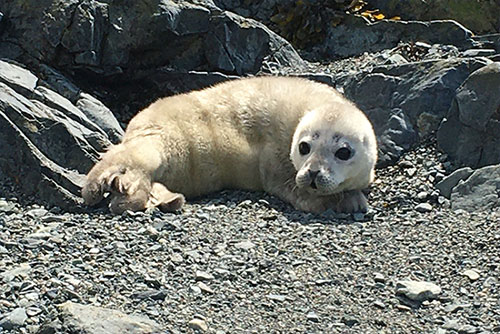Premature harbor seal pup born with lanugo (natal fur) in Haines, Alaska. |
Mothers give birth to one pup during the spring. At birth, harbor seals weigh around 24 pounds, but they gain weight rapidly during pupping season. Pups will stay with their mothers for 4 to 6 weeks before they are weaned and able to forage on their own. It is essential these seal pups learn to forage on their own, and during this weaning process, they tend to rest on shore without their moms.
What To Do If You Find a PupWhile it may seem that these pups are on their own, their mothers are often close by or can be away for more than 24 hours. Below are some tips to keep in mind when you see a pup on its own:
- Always stay at least 100 yards away from harbor seals and other marine mammals
- Keep dogs on leashes
- Remember that seal moms can stay away for 24 to 48 hours
- Signs of mom being nearby include the pup moving up and down the shoreline and in and out of the water; seals nearby in the water; and tracks around the pup
- Pups tend to haul out of the water in the same location, and may be observed at the same spot over multiple days or weeks
If a seal appears to be injured or in distress, call the NOAA Fisheries Alaska Marine Mammal Stranding Hotline at (877) 925-7773.
- Do not approach the seal or attempt to provide care
- If possible collect photos while keeping your distance - photos help stranding network members assess the seal's condition
Up to 50 percent of pups do not survive their first year of life, and while we tend to want to help, their best chance of survival is in nature. Many pups are not wary of humans and will not try to escape when approached, meaning that it is extra important to give them space. A healthy fear response is needed for survival.
If pups are disturbed during pupping season, their mothers may abandon them before they are weaned, reducing their likelihood of surviving. It’s essential that we give them space and share the shore with these protected animals. Never approach or pick up a seal pup - it is dangerous to both you and the seal. Observing these adorable pups from a distance is the best way that you can help ensure that they grow up and live a healthy life.
Edited By: Mary Kauffman, SitNews
Source of News:
NOAA
www.fisheries.noaa.gov
Representations of fact and opinions in comments posted are solely those of the individual posters and do not represent the opinions of Sitnews.
Send a letter to the editor@sitnews.us
SitNews ©2022
Stories In The News
Ketchikan, Alaska
Articles & photographs that appear in SitNews are considered protected by copyright and may not be reprinted without written permission from and payment of any required fees to the proper freelance writers and subscription services.
E-mail your news & photos to editor@sitnews.us
Photographers choosing to submit photographs for publication to SitNews are in doing so granting their permission for publication and for archiving. SitNews does not sell photographs. All requests for purchasing a photograph will be emailed to the photographer.

